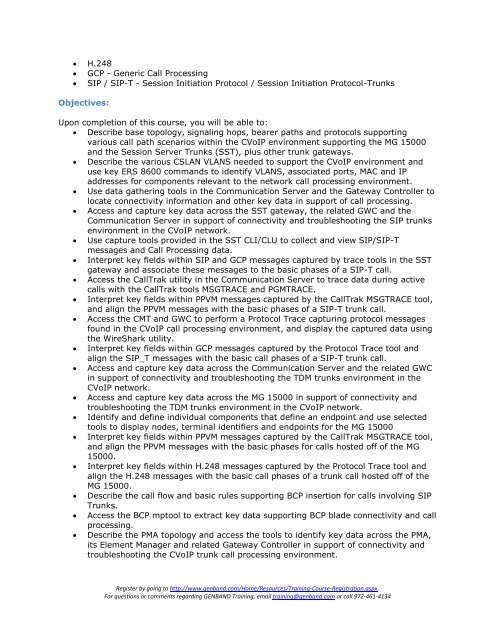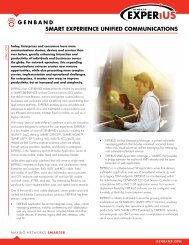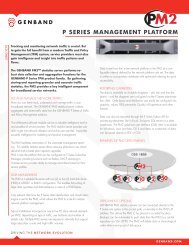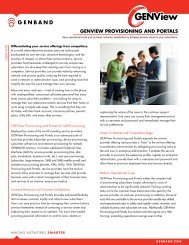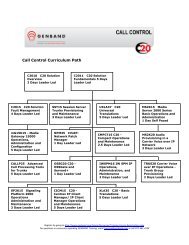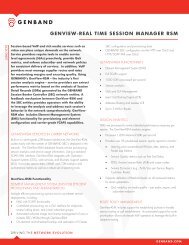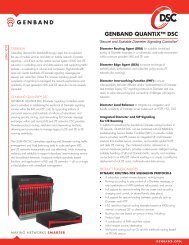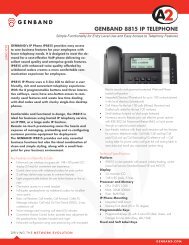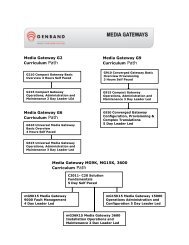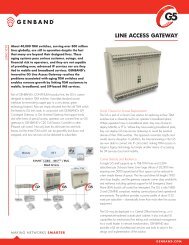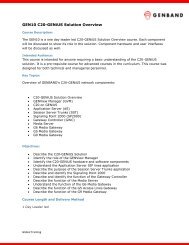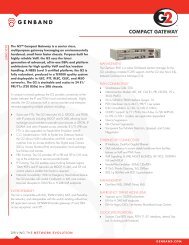Call Control Curriculum Path - Genband
Call Control Curriculum Path - Genband
Call Control Curriculum Path - Genband
- No tags were found...
Create successful ePaper yourself
Turn your PDF publications into a flip-book with our unique Google optimized e-Paper software.
H.248 GCP - Generic <strong>Call</strong> Processing SIP / SIP-T - Session Initiation Protocol / Session Initiation Protocol-TrunksObjectives:Upon completion of this course, you will be able to: Describe base topology, signaling hops, bearer paths and protocols supportingvarious call path scenarios within the CVoIP environment supporting the MG 15000and the Session Server Trunks (SST), plus other trunk gateways. Describe the various CSLAN VLANS needed to support the CVoIP environment anduse key ERS 8600 commands to identify VLANS, associated ports, MAC and IPaddresses for components relevant to the network call processing environment. Use data gathering tools in the Communication Server and the Gateway <strong>Control</strong>ler tolocate connectivity information and other key data in support of call processing. Access and capture key data across the SST gateway, the related GWC and theCommunication Server in support of connectivity and troubleshooting the SIP trunksenvironment in the CVoIP network. Use capture tools provided in the SST CLI/CLU to collect and view SIP/SIP-Tmessages and <strong>Call</strong> Processing data. Interpret key fields within SIP and GCP messages captured by trace tools in the SSTgateway and associate these messages to the basic phases of a SIP-T call. Access the <strong>Call</strong>Trak utility in the Communication Server to trace data during activecalls with the <strong>Call</strong>Trak tools MSGTRACE and PGMTRACE. Interpret key fields within PPVM messages captured by the <strong>Call</strong>Trak MSGTRACE tool,and align the PPVM messages with the basic phases of a SIP-T trunk call. Access the CMT and GWC to perform a Protocol Trace capturing protocol messagesfound in the CVoIP call processing environment, and display the captured data usingthe WireShark utility. Interpret key fields within GCP messages captured by the Protocol Trace tool andalign the SIP_T messages with the basic call phases of a SIP-T trunk call. Access and capture key data across the Communication Server and the related GWCin support of connectivity and troubleshooting the TDM trunks environment in theCVoIP network. Access and capture key data across the MG 15000 in support of connectivity andtroubleshooting the TDM trunks environment in the CVoIP network. Identify and define individual components that define an endpoint and use selectedtools to display nodes, terminal identifiers and endpoints for the MG 15000 Interpret key fields within PPVM messages captured by the <strong>Call</strong>Trak MSGTRACE tool,and align the PPVM messages with the basic phases for calls hosted off of the MG15000. Interpret key fields within H.248 messages captured by the Protocol Trace tool andalign the H.248 messages with the basic call phases of a trunk call hosted off of theMG 15000. Describe the call flow and basic rules supporting BCP insertion for calls involving SIPTrunks. Access the BCP mptool to extract key data supporting BCP blade connectivity and callprocessing. Describe the PMA topology and access the tools to identify key data across the PMA,its Element Manager and related Gateway <strong>Control</strong>ler in support of connectivity andtroubleshooting the CVoIP trunk call processing environment.Register by going to http://www.genband.com/Home/Resources/Training-Course-Registration.aspx.For questions or comments regarding GENBAND Training, email training@genband.com or call 972-461-4134


